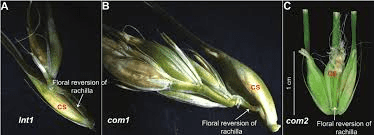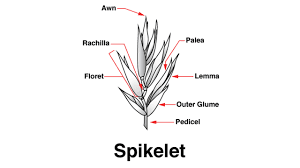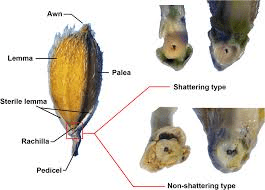The sorghum rachis is an important structural component of the sorghum panicle, which is the flowering head of the sorghum plant (Sorghum bicolor). The rachis serves as the central axis or backbone of the panicle, providing support and organization for the arrangement of flowers and seeds.
The rachis is a long, slender stalk that extends from the top of the sorghum plant and branches out into smaller secondary stems called racemes. Each raceme bears a number of small individual flowers, which, after pollination, develop into seeds. The primary role of the rachis is to provide structural support to these racemes, ensuring that they are positioned in an optimal arrangement for effective pollination.
Structurally, the rachis is composed of a central axis with branching points where the racemes attach. It is usually cylindrical and can vary in thickness depending on the sorghum variety and environmental conditions. The rachis is made up of vascular tissues, which include xylem and phloem, that transport water, nutrients, and sugars between the plant’s leaves, stalk, and the developing flowers.
The design of the rachis plays a crucial role in the overall development and yield of the sorghum crop. A well-developed rachis can support a large number of racemes and flowers, which in turn can lead to higher seed production. The strength and flexibility of the rachis are important for withstanding environmental factors such as wind and rain, which can otherwise cause damage and reduce crop yields.
In addition to its structural role, the rachis also influences the distribution of flowers and seeds within the panicle. The arrangement of flowers on the rachis affects the efficiency of pollination and the uniformity of seed development. Proper spacing and positioning of the flowers ensure that each flower receives adequate pollen and that the seeds have enough space to mature fully.
The morphology of the rachis can vary among different sorghum varieties. Some varieties may have a more rigid and thick rachis to support dense, compact panicles, while others may have a more flexible rachis to accommodate larger, more open panicles. Environmental conditions, such as nutrient availability and water supply, also impact the development of the rachis and the overall productivity of the plant.
Understanding the function and characteristics of the sorghum rachis is important for optimizing sorghum cultivation practices. For example, farmers and researchers might select varieties with desirable rachis traits to improve harvest efficiency and seed quality. Additionally, managing environmental factors to support healthy rachis development can lead to better crop yields and more resilient sorghum plants.
The sorghum rachis is a critical component of the sorghum panicle, providing essential support and organization for the flowering and seed development process. Its structure and function play a significant role in determining the overall productivity and health of the sorghum crop.
The Economic Importance and Uses of Sorghum Rachis

1. Grain Support: The rachis is crucial for holding and distributing the sorghum grains, which are essential for food and feed.
2. Animal Feed: After harvest, the rachis and other plant residues can be used as high-fiber feed for livestock.
3. Biofuel Production: The rachis can be processed into biomass for bioethanol or biogas, contributing to renewable energy sources.
4. Soil Improvement: When decomposed, the rachis adds organic matter to the soil, improving fertility and structure.
5. Erosion Control: The rachis and plant residues help stabilize the soil, preventing erosion.
6. Organic Mulch: The rachis can be used as mulch to retain soil moisture and suppress weeds.
7. Composting: The rachis is excellent for composting, contributing to the creation of nutrient-rich compost.
8. Crafting Materials: Dried rachis can be used in crafting, including making brooms, baskets, and other decorative items.
9. Animal Bedding: The rachis can be used as bedding material for livestock, providing comfort and hygiene.
10. Biodegradable Products: Processed rachis can be used to create biodegradable materials and packaging products.
11. Green Manure: Plant residues, including the rachis, can be used as green manure to enhance soil fertility.
12. Carbon Sequestration: Sorghum cultivation, including the rachis, helps capture carbon dioxide from the atmosphere, contributing to climate change mitigation.
13. Natural Pest Repellents: Extracts from the rachis can be used to create natural pest repellents.
14. Nutrient Cycling: The rachis plays a role in nutrient cycling, making essential minerals available to plants.
15. Agroforestry Systems: The rachis can be integrated into agroforestry systems to support sustainable land management and improve biodiversity.
16. Natural Adhesives: Extracts from the rachis can be used to produce natural adhesives for various applications.
17. Green Building Materials: Processed rachis can be used in the production of eco-friendly building materials.
18. Water Filtration: The rachis can be used in natural water filtration systems to remove impurities.
Read Also: How often you need to Change Water in your Fish Farm
The Products and By-products That Can Be Derived From Sorghum Rachis

1. Animal Feed: The rachis can be processed into high-fiber feed for livestock.
2. Bioethanol: The rachis can be used to produce bioethanol through fermentation.
3. Compost: Decomposed rachis contributes to nutrient-rich compost for gardening and farming.
4. Mulch: The rachis can be used as mulch to retain soil moisture and suppress weeds.
5. Craft Materials: Dried rachis is used to make crafts such as brooms, baskets, and decorative items.
6. Biodegradable Packaging: Processed rachis can be used to create biodegradable packaging materials.
7. Natural Pest Repellents: Extracts from the rachis are used to create natural pest repellents.
8. Renewable Energy: The rachis can be used to produce heat energy through direct combustion.
9. Green Manure: The rachis can be plowed back into the soil to improve fertility as green manure.
10. Natural Adhesives: Extracts from the rachis can be processed into natural adhesives.
11. Water Filtration Systems: The rachis can be used in natural water filtration systems.
12. Green Building Materials: Processed rachis can be used to create eco-friendly construction materials.
13. Textile Fibers: Fibers from the rachis can be used in textile manufacturing.
14. Nutrient Additives: Processed rachis can be added to animal feed as a source of additional nutrients.
15. Bioremediation Agents: The rachis can be used in bioremediation products to clean contaminated soils.
16. Soil Conditioner: Decomposed rachis improves soil health and structure.
17. Natural Dyes: Extracts from the rachis can be used to produce natural dyes for textiles.
Read Also: 14 Medicinal Health Benefits of Ghost Pepper (Capsicum Chinese)
Frequently Asked Questions (FAQ’s) About Sorghum Rachis

1. What is the main function of the sorghum rachis?
The sorghum rachis supports and distributes the sorghum grains, which are essential for food and feed production.
2. Can sorghum rachis be used as animal feed?
Yes, after harvest, the rachis can be used as high-fiber feed for livestock.
3. How does the sorghum rachis contribute to soil health?
When decomposed, the rachis adds organic matter to the soil, improving its fertility and structure.
4. Can sorghum rachis be used in biofuel production?
Yes, the rachis can be processed into biomass for bioethanol or biogas.
5. Are there any crafting uses for sorghum rachis?
Yes, dried rachis can be used to make brooms, baskets, and other decorative items.
6. How does sorghum rachis help with erosion control?
The rachis and plant residues help stabilize soil and prevent erosion.
7. Can sorghum rachis be used for renewable energy?
Yes, the rachis can be used to produce heat energy through direct combustion.
8. Is sorghum rachis beneficial for composting?
Yes, the rachis is excellent for composting, contributing to the production of nutrient-rich compost.
9. How does sorghum rachis contribute to carbon sequestration?
The rachis helps capture carbon dioxide from the atmosphere, aiding in climate change mitigation.
10. Can sorghum rachis be used in natural pest control?
Yes, extracts from the rachis can be used to create natural pest repellents.






